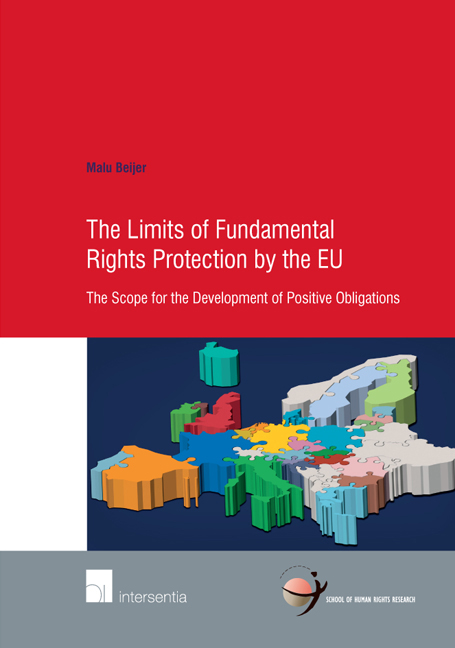 Limits of Fundamental Rights Protection by the EU
Limits of Fundamental Rights Protection by the EU Book contents
- Frontmatter
- About the Author
- Acknowledgements
- Contents
- Abbreviations
- Table of Cases
- Chapter 1 Introduction
- PART I THE CONCEPT OF POSITIVE OBLIGATIONS WITHIN THE CONTEXT OF THE EUROPEAN CONVENTION ON HUMAN RIGHTS
- Chapter 2 The System of Fundamental Rights Protection Under the European Convention on Human Rights
- Chapter 3 The Development of Positive Obligations Under the European Convention on Human Rights
- Chapter 4 A Critical Appraisal of the Development of Positive Obligations Under the European Convention on Human Rights
- Chapter 5 Part I – Conclusions
- PART II THE SCOPE FOR THE DEVELOPMENT OF POSITIVE OBLIGATIONS WITHIN THE CONTEXT OF EU LAW – AN ANALYSIS OF THE SPECIFIC PARAMETERS OF THE EU LEGAL ORDER AND THE EU SYSTEM OF FUNDAMENTAL RIGHTS PROTECTION
- PART III SYNTHESIS
- Bibliography
- Index
- Miscellaneous Endmatter
Chapter 3 - The Development of Positive Obligations Under the European Convention on Human Rights
from PART I - THE CONCEPT OF POSITIVE OBLIGATIONS WITHIN THE CONTEXT OF THE EUROPEAN CONVENTION ON HUMAN RIGHTS
Published online by Cambridge University Press: 27 September 2018
- Frontmatter
- About the Author
- Acknowledgements
- Contents
- Abbreviations
- Table of Cases
- Chapter 1 Introduction
- PART I THE CONCEPT OF POSITIVE OBLIGATIONS WITHIN THE CONTEXT OF THE EUROPEAN CONVENTION ON HUMAN RIGHTS
- Chapter 2 The System of Fundamental Rights Protection Under the European Convention on Human Rights
- Chapter 3 The Development of Positive Obligations Under the European Convention on Human Rights
- Chapter 4 A Critical Appraisal of the Development of Positive Obligations Under the European Convention on Human Rights
- Chapter 5 Part I – Conclusions
- PART II THE SCOPE FOR THE DEVELOPMENT OF POSITIVE OBLIGATIONS WITHIN THE CONTEXT OF EU LAW – AN ANALYSIS OF THE SPECIFIC PARAMETERS OF THE EU LEGAL ORDER AND THE EU SYSTEM OF FUNDAMENTAL RIGHTS PROTECTION
- PART III SYNTHESIS
- Bibliography
- Index
- Miscellaneous Endmatter
Summary
INTRODUCTION
This chapter aims to define the meaning of the concept of positive obligations and its implications for the Convention system. A clear basis of the concept of positive obligations is needed so that it can be applied and further examined within the specific context of EU law (see part II). Scholars such as Mowbray, Xenos and, most recently, Lavrysen have undertaken important studies on the development of positive obligations by the ECtHR, which will be relied on in this chapter. These studies also show that there continues to be discussion on some aspects of the development of positive obligations by the ECtHR. Therefore, a further study of the case-law of the ECtHR itself is also undertaken here in order to discover how the ECtHR specifically understands and defines the concept of positive obligations.
This chapter begins by describing how the ECtHR introduced the concept of positive obligations in its case-law (section 3.2.1.). It then looks at how the ECtHR defines positive obligations (section 3.2.2.); how the distinction between positive and negative obligations is made (section 3.2.3.); the general rationale expressed for recognising positive obligations (section 3.2.4.); which explicit legal bases are used (section 3.2.5.); and the methodology applied by the ECtHR in order to determine the existence of positive obligations under the Convention (section 3.2.6.). The first part of this analysis is followed by an overview of several typologies of positive obligations that can be made (section 3.3.), and a discussion of the implications of the recognition of the different kinds of positive obligations, both for states and for individuals (section 3.4.). Thereaft er, important limitations on the scope of positive obligations that can be found in the case-law of the ECtHR are highlighted (section 3.5.). A few main observations on the concept of positive obligations are brought together in the conclusions (section 3.6.).
THE DEVELOPMENT OF POSITIVE OBLIGATIONS BY THE ECtHR
THE BELGIAN LINGUISTIC CASE: INTRODUCING POSITIVE OBLIGATIONS
The ECtHR introduced the concept of positive obligations for the first time in the Belgian Linguistic case in 1968, which was only its sixth judgment. In this judgment, the ECtHR provided important reasoning on how the concept of positive obligations was to be understood within the context of the Convention, and it is therefore dealt with here in detail.
- Type
- Chapter
- Information
- Limits of Fundamental Rights Protection by the EUThe Scope for the Development of Positive Obligations, pp. 37 - 70Publisher: IntersentiaPrint publication year: 2017
